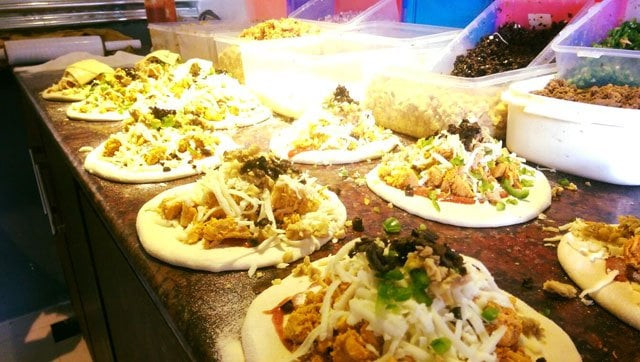Phenome-Naan: A contemporary twist on a timeless classic
Unravelling the rising trend of naan shops in Punjab

Phenome-Naan: a contemporary twist on a timeless classic. PHOTO: Naan Dhaba
Cafeela conquers desi cuisine
The meteoric rise of the concept introduced by MT led to this idea being rapidly replicated across Lahore and Islamabad. For instance, Usman Iftikhar, one of the owners of Mr. Sheeda (MS) in Lahore, wanted to incorporate continental tastes into a local staple. Bakhtawar Taimoor Khan, co-founder of Naan Dhaba (ND) in Islamabad also openly admits to being inspired by similar enterprises in Lahore but thought there was a lack of variety. Similarly, the founders of Naan Stop (NS) in Islamabad studied the concept and improved upon the idea to fit their market. As a result, Islamabad and Rawalpindi have seen launches of at least seven different naan outlets in the last six months.
 PHOTO: Naan Dhaba
PHOTO: Naan DhabaMost of these outlets are run by 20-somethings from all walks of life. NS is an initiative of four business graduates, MS has a mixture of employed people and students, ND was opened by four engineers, while MT consists of four students who will graduate later this year.
According to Abdul Azeem, from ND, baking a flatbread is much more complex than it looks. “We first tried kneading the dough, how you would for a normal naan, but that did not work,” he explains. “Every day we would try three to four different types of flour combinations, figuring out the dough took us a month,” adds Azeem. This team experimented with a variety of flavours, from M&M’s and dairy milk to jams, and the items that could not be filled inside the naan were applied on top of it.
The menu at these flatbread outlets cater to a wide range of taste buds. Flavours vary from savoury items, such as pizza or chicken tikka, to sweet dishes, including Nutella and marshmallows, to exotic naans comprising of jalapenos and dry fruits. They offer food at prices ranging from Rs100 to Rs400 per naan.
Growing pains
MT almost never made it. Their lack of experience in a competitive market caused a shut down for 10 days, where they fired all their employees two weeks into their opening. “We made a lot of mistakes and our employees literally ran all over us,” elaborates Minhas. “But we were determined to make the restaurant work. During those 10 days we decided to learn all the processes ourselves – that’s how we came up with our signature naans and built a unique team dynamic that led to our success,” he informs.
 PHOTO: Maro Tandoor
PHOTO: Maro TandoorLikewise labour issues plagued the NS team at the beginning as they tried the unconventional and modern ‘no boss’ approach, which is ideal but impractical. “Our first team tried to exploit us, so we fired the whole lot and hired new employees,” cautions founder Mohammed Ahmed. “Although our shop remained shut for two days, we learned the processes ourselves to prevent a situation such as this from happening again,” he mentions. On the other hand, location was another critical factor for the eatery. It took them two months to finalise a setting that allowed for outdoor seating to fit into their street food concept. Co-founder Talha Gohar claims that this desire culminated in the opening of a dhaba where families would also be comfortable.
Moreover, running a business is just as challenging as highlighted by Ifthikhar. “On our opening day we realised we were not prepared for the turnout,” he recalls. However, with time they kept working on improving their management issues with just one rule in mind: customer is always right. Similarly, the guys at ND did not have a calculator on their opening night. “We had a lot of issues with procurement. We thought we had bought enough stock for three days, but it turned out it was enough for only half a day,” mentions Azeem.
One of the misconceptions about this business is that the initial investment is very low, a myth the tandoor enterprises would like to bust. According to the entrepreneurs they started off with huge funds that were collected from parents, personal savings or loans granted by friends and extended family.
At the time of inception, MT’s initial capital was Rs1 million, ND put in Rs2 million, MS invested Rs3 million and NS collected Rs4 million. All of them had to put in more capital once they got started. “People assume you can spend just a few lakhs and you are ready to go. Sure, that much capital will get you a tandoor but is not enough to build a brand,” says Gohar. “The property for the tandoor eats into most of the initial capital,” he adds.
The families of the entrepreneurs have played a huge role in their success. “They were the reason that we were able to implement our ideas, especially their assistance in refining our recipes,” explains Ifthikhar. Similarly, despite apprehension at the inception, the founders of ND and MT now enjoy their family’s support. “Initially, they did not want our venture to interfere with our studies,” points out Minhas. “But they gradually realised that once our business took off, it would become the focus of our lives rather than being a side project,” he adds.
But for NS co-founder Mohammed Ahmed, the success of his eatery did not change his family’s unsupportive attitude. He still gets calls from his parents to find a ‘proper’ job. “If your family is business oriented they encourage you even if you have a rairi (cart),” he says. “But my family’s business has been limited to buying a plot or two; so I would get warnings that my business partners might trick me or that I would do something illegal etcetera in business,” he comments.
Stuffing it right
Even though, the tandoor houses featured have gone from strength to strength after their openings, the enterprises in Islamabad did not have a well thought-out marketing campaign. “We had a marketing plan but the initial turnout was so strong we decided to ride the wave of positive word of mouth,” says Khan.
Experiencing a similar situation, the NS team added the truck art theme to enhance the street food concept. However, Minhas and his marketing team launched two very innovative social media campaigns featuring puns on fast food chains and lawn suit collections.
The growth of these outlets is reflected by their sales. In Lahore, MT leads the way by claiming they serve around 1000 people daily, while MS assert they serve up to 800 people via their three outlets on a day.
Naansense heightens gastronomic senses
In Islamabad, ND and NS serve between 300-400 people and 500 customers per day respectively. The numbers vary with season and most tandoors anticipate a dip during summers.
Moreover, the USP of three out of four outlets is their Nutella naans, which is reported to be their top sellers corroborating the rising trend of the hazelnut-cocoa spread filled naans. Furthermore, the bestsellers reveal a consistency in the preference of the customers. MS and ND list their Barbeque and Chicken Tikka naans respectively as the preferred choices, while MT and NS say their Pizza Naan and Cheese Naan, respectively, are very popular.
Expanding the business
All four outlets have expansion plans in the near future. MS wants to take this concept overseas and believes in its potential for an international chain in the vein of a Pakistani McDonald’s or Pizza Hut. The entrepreneurs feel that having overcome initial challenge of introducing the product to the market, the time is apt to launch new flavour combinations along with rapid expansion, all while making sure that the quality of the product is not compromised.
Meanwhile, the engineers at ND are putting their technical qualification to good use by working on a temperature controlled tandoor that would standardise their production line. “We are also working on a mechanism to help keep our products warm,” says Azeem.
On the other hand, NS plans on launching campaigns targeted at kids. “Our inspiration is the Happy Meal that attracts kids which in turn pulls in their parents to the outlet as well,” points out Gohar.
The founder of all these ventures belong from a variety of backgrounds and have pursued different kind of degrees, but they all have one thing in common: the desire to want to do more than just daily jobs and the guts to pursue that passion. “The most important advice for entrepreneurs is to take the plunge,” exclaims Minhas. “If you want to pursue something go for it and don’t wait around for someone else,” he advices.
Ans Khurram is a freelance writer.



















COMMENTS
Comments are moderated and generally will be posted if they are on-topic and not abusive.
For more information, please see our Comments FAQ